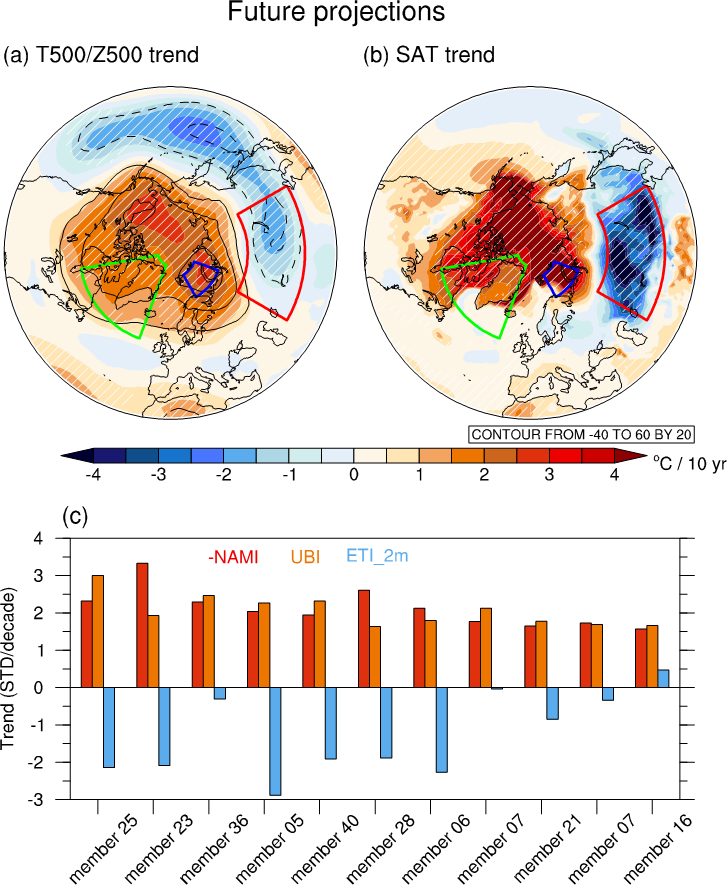气候变暖使得全球气温升高,但北半球中高纬冬季气温很大程度上受到内部变率的调制作用。比如,从1990年代至2010年代初,欧亚冬季出现了显著的变冷趋势。
最新观测结果显示,冬季欧亚变冷趋势在近10年显著减弱(图1)。基于再分析和大样本试验结果,本研究发现了近10年冬季欧亚变冷趋势的减弱与北极(对流层中层)增暖趋势的减弱一致,并揭示了大气内部变率的重要作用。进一步研究表明,北极涛动负位相和乌拉尔山阻塞高压的共同减弱导致了北极(对流层中层)增暖–欧亚变冷趋势的减弱。

Figure 1. (a–b) Liner trends of SAT (°C decade-1) during winters of (a) 1990–2013 and (b) 1990–2020 from ERA5. (c–d) Same as (a–b), but for T500 (°C decade-1; shading) and Z500 (m decade-1; contours). Regions with temperature trends statistically significant at the 95% confidence level are marked with slash.
基于CESM-LENS的预估结果(高排放情景)表明,在本世纪中叶之前,即大气内部变率作用有可能强于温室气体强迫作用时,若北极涛动负位相和乌拉尔山阻塞高压均出现显著的增强趋势,冬季北极(对流层中层)增暖–欧亚变冷趋势可能再次发生(图2)。
基于CMIP6多模式不同排放情景的预估结果表明,在本世纪中期(2021–2050),欧亚冬季变冷趋势受排放情景的影响较小;不同排放情景下的欧亚冬季变冷趋势接近,均伴随着北极深层变暖趋势、及北极反气旋环流趋势。到本世纪末期(2070–2099),欧亚冬季变冷趋势的概率会随着温室气体排放的增加而减小(由SSP126很低排放情景的14.8%变为SSP585很高排放情景的0.9%)。

Figure 2. (a) Composited mean linear trends of T500 (°C decade-1; shading) and Z500 (m decade-1; contours) for 11 cases with the strongest 10-yr upward trends of negative NAMI and positive UBI, during winters of 2023–2050 from 10 ensemble members of the CESM-LENS. (b) Same as (a), but for SAT (°C decade-1). Regions with temperature trends statistically significant at the 95% confidence level are marked with slash. (c) Linear trends of the negative NAMI, UBI and ETI_2m for the 11 cases.
本研究进一步关注了欧亚冬季极端低温的未来预估(图3)。在本世纪中期(2021–2050),欧亚冬季极端低温异常强度(低于极端低温阈值2~3°C)和频次(低于极端低温阈值4~6天)受排放情景的影响小。到本世纪末期,相对于低排放情景,高排放情景下的气候变暖将显著削减欧亚冬季极端低温的频次和强度。
因此,在本世纪中期(2021–2050),欧亚冬季气温变化趋势和极端天气将主要受内部变率(比如乌拉尔山阻塞高压)的调制。如果碳中和目标在本世纪中期之后达成,欧亚冬季气温受内部变率的影响将越来越大。

Figure 3. (a–h) Composite Eurasian winter extreme cold anomalies in the near-term (i.e., 2021–2050) and long-term (i.e., 2070–2099) under four emission scenarios (i.e., SSP126, SSP245, SSP370, and SSP585) derived from 22 CMIP6 CGCMs. (i–p) Same as (a–h), but for extreme cold days.
文章信息:
Xu, X., S. He, B. Zhou, and B. Sun, 2024: CMIP6 near-term and long-term projections of Eurasian winter cooling trend and cold extremes. Environmental Research Letters, 19, 104038.
Xu, X., S. He, B. Zhou, H. Wang, and B. Sun, 2023: Arctic warming and Eurasian cooling: weakening and reemergence. Geophysical Research Letters, 50, e2023GL105180.